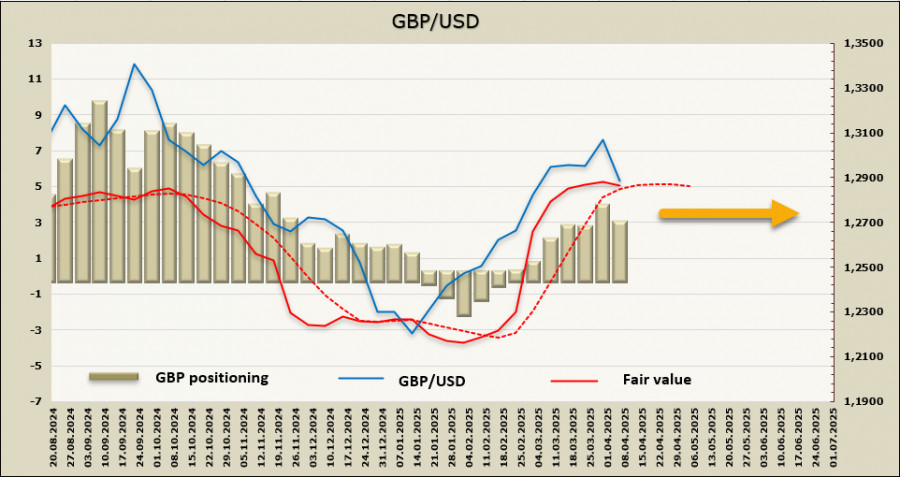See also


 08.04.2025 12:58 AM
08.04.2025 12:58 AMThe United Kingdom is among the few G20 countries that got off relatively lightly—it was hit with a 25% tariff on car exports and a 10% tariff on other goods. This is significantly lower than the new tariffs imposed on China, the EU, or Japan, giving the British economy a fair chance to benefit, at least marginally, from the changing trade landscape.
As of 2023, the UK exported £60.4 billion worth of goods to the United States, accounting for 15.3% of its total exports. Now, exporters face a tough choice—either lower prices to remain competitive or reduce output in anticipation of weaker demand. The former seems unlikely, considering the increase in the minimum wage and cost of living, meaning businesses will most likely cut production. This, in turn, will lead to job losses and rising unemployment.
A decline in exports will also put downward pressure on the British pound. Additionally, increased demand for the U.S. dollar as a safe haven is likely. The only factor that could halt this process is the swift onset of a recession in the U.S.—and it would need to happen before similar slowdowns take hold in the countries facing higher U.S. import tariffs.
Meanwhile, the UK imported £57.9 billion worth of goods and £57.4 billion in services from the U.S. in 2023. These will now become more expensive, contributing to higher inflation. The Bank of England has declared a gradual and cautious approach to rate cuts. However, in light of this new threat and rising inflation expectations, rates may be elevated for a longer period. This will add pressure to GDP but could support the pound, especially as market expectations for Federal Reserve rate cuts are shifting toward a faster timeline.
The net long position on GBP declined by £0.8 billion over the reporting week, to £2.8 billion. Positioning remains bullish for now, but the calculated price dynamic—still holding above the long-term average—is beginning to turn bearish.
Last week, the pound reached a six-month high but saw a sharp pullback on Friday that continued into the start of the new week. GBP failed to consolidate above 1.3013, retreating to the technical support level of 1.2782 (38% of the year-to-date gains). The 1.2780–1.2810 support zone is quite significant, and the pound's next moves largely depend on whether it holds this level. A drop below could open the way to 1.2650. If the pound holds above support, a wide trading range between 1.2780 and 1.3200 may form, where GBP could consolidate for some time as the market repositions itself in response to the new global trade realities.
You have already liked this post today
*The market analysis posted here is meant to increase your awareness, but not to give instructions to make a trade.
On Thursday, investors realized there is currently no such thing as stability. High market volatility remains and will continue to dominate for some time. The ongoing cause of this remains
A relatively large number of macroeconomic events are scheduled for Friday, but none are expected to impact the market. Of course, we may see short-term reactions to individual reports
The GBP/USD currency pair also traded higher on Thursday. As a reminder, macroeconomic and traditional fundamental factors currently have little to no influence on currency movements. The only thing that
The GBP/USD currency pair also showed strong growth on Thursday, although not as strong as the EUR/USD pair. The pound gained only around 200 pips—which isn't a considerable move under
The CPI report released on Thursday showed weaker-than-expected inflation. The market responded accordingly: the U.S. dollar came under renewed pressure (the U.S. Dollar Index fell into the 100.00 range)
Training video

Your IP address shows that you are currently located in the USA. If you are a resident of the United States, you are prohibited from using the services of InstaFintech Group including online trading, online transfers, deposit/withdrawal of funds, etc.
If you think you are seeing this message by mistake and your location is not the US, kindly proceed to the website. Otherwise, you must leave the website in order to comply with government restrictions.
Why does your IP address show your location as the USA?
Please confirm whether you are a US resident or not by clicking the relevant button below. If you choose the wrong option, being a US resident, you will not be able to open an account with InstaTrade anyway.
We are sorry for any inconvenience caused by this message.


